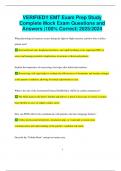VERIFIED!! EMT Exam Prep Study
Complete Mock Exam Questions and
Answers |100% Correct| 2025/2024
What physiological response occurs during the fight-or-flight reaction, and how does it affect
patient care?
Increased heart rate, heightened alertness, and rapid breathing occur, requiring EMTs to
assess and manage potential complications in anxious or distressed patients.
Explain the importance of reassessing vital signs after initial interventions.
Reassessing vital signs helps to evaluate the effectiveness of treatments and monitor changes
in the patient's condition, allowing for timely adjustments in care.
What is the role of the Automated External Defibrillator (AED) in cardiac emergencies?
The AED analyzes the heart's rhythm and delivers a shock if necessary to restore a normal
heart rhythm in cases of sudden cardiac arrest.
How can EMTs effectively communicate with patients who have language barriers?
Utilize professional interpreters, translation apps, or visual aids to ensure clear
communication and understanding of the patient's condition and needs.
Describe the "Golden Hour" concept in trauma care.
1
, The "Golden Hour" refers to the critical first hour following a traumatic injury, emphasizing
the importance of rapid assessment and transport to improve survival rates.
What factors should be considered when determining the transport destination for a patient?
Consider the patient's condition, the proximity of the closest hospital, the level of care
required, and the specific capabilities of receiving facilities.
What is the rationale behind using the head-tilt/chin-lift maneuver for airway management in an
unresponsive patient?
This maneuver opens the airway by lifting the tongue away from the back of the throat,
ensuring proper ventilation without causing cervical spine injury.
How does the EMT assess for a potential pneumothorax in a trauma patient?
Look for signs such as diminished breath sounds on one side, tracheal deviation, and
asymmetrical chest expansion during inhalation.
What steps should an EMT take when encountering a patient with a suspected stroke?
Use the FAST acronym: Face drooping, Arm weakness, Speech difficulties, and Time to call
for immediate medical assistance.
How do you recognize signs of a potential myocardial infarction (heart attack) in a patient?
Look for chest pain or discomfort, radiating pain to the arms, jaw, or back, shortness of
breath, nausea, and sweating.
2
,Explain the significance of using a cervical collar for a patient with suspected spinal injury.
A cervical collar stabilizes the neck and prevents further injury to the spinal cord while
minimizing movement during transport.
What is the appropriate response if a patient presents with heat stroke?
Move the patient to a cooler environment, remove excess clothing, and initiate cooling
measures such as applying cool, wet cloths and monitoring vital signs closely.
How should EMTs approach a patient experiencing a behavioral emergency?
Maintain a calm demeanor, assess the scene for safety, establish rapport, and communicate
clearly while ensuring the safety of both the patient and providers.
What is the correct technique for performing a one-rescuer CPR on an adult?
Position hands on the center of the chest, compress at least 2 inches deep at a rate of 100-120
compressions per minute, allowing full chest recoil between compressions.
How can EMTs differentiate between asthma and chronic obstructive pulmonary disease (COPD)
during assessment?
Asthma often presents with wheezing and is usually triggered by specific factors, while
COPD typically has a chronic cough and may present with barrel chest and diminished breath
sounds.
3
, What actions should an EMT take when a patient presents with suspected anaphylaxis?
Administer epinephrine if prescribed, maintain airway patency, and prepare for rapid
transport while monitoring vital signs and assessing response to treatment.
Describe the importance of documentation in prehospital care and the key elements it should
include.
Documentation ensures a legal record of care, facilitates continuity of treatment, and should
include patient assessment findings, interventions performed, and the patient’s response.
How do you assess the effectiveness of a tourniquet applied to a bleeding limb?
Ensure bleeding has stopped, assess the distal pulse, check for changes in skin color, and
monitor for any signs of compartment syndrome.
What considerations should EMTs keep in mind when providing care to geriatric patients?
Consider factors such as polypharmacy, age-related physiological changes, cognitive
impairments, and the increased risk of complications during assessment and treatment.
Explain the significance of using appropriate lifting techniques when handling patients.
Proper lifting techniques reduce the risk of injury to both the patient and the EMT, ensuring
safety and maintaining the dignity of the patient during transport.
What steps should be taken if a patient refuses care after being assessed?
4




